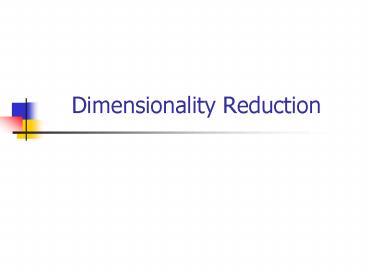Dimensionality Reduction - PowerPoint PPT Presentation
Title:
Dimensionality Reduction
Description:
GEMINI ... GEMINI framework. PCA ... di(a,b) = sign(di(a,b)) (| di(a,b) |2)1/2. where, di(a,b) = di-1(a,b)2 (xia-xbi)2 ... – PowerPoint PPT presentation
Number of Views:74
Avg rating:3.0/5.0
Title: Dimensionality Reduction
1
Dimensionality Reduction
2
Multimedia DBs
- Many multimedia applications require efficient
indexing in high-dimensions (time-series, images
and videos, etc) - Answering similarity queries in high-dimensions
is a difficult problem due to curse of
dimensionality - A solution is to use Dimensionality reduction
3
High-dimensional datasets
- Range queries have very small selectivity
- Surface is everything
- Partitioning the space is not so easy 2d cells
if we divide each dimension once - Pair-wise distances of points are very skewed
freq
distance
4
Dimensionality Reduction
- The main idea reduce the dimensionality of the
space. - Project the d-dimensional points in a
k-dimensional space so that - k ltlt d
- distances are preserved as well as possible
- Solve the problem in low dimensions
5
Multi-Dimensional Scaling
- Map the items in a k-dimensional space trying to
minimize the stress - Steepest Descent algorithm
- Start with an assignment
- Minimize stress by moving points
- But the running time is O(N2) and O(N) to add a
new item
6
Embeddings
- Given a metric distance matrix D, embed the
objects in a k-dimensional vector space using a
mapping F such that - D(i,j) is close to D(F(i),F(j))
- Isometric mapping
- exact preservation of distance
- Contractive mapping
- D(F(i),F(j)) lt D(i,j)
- d is some Lp measure
7
GEMINI
- Using the contractive property (lower bounding
lemma) we can show that we can use the index in
the lower dimensional space to retrieve the exact
answer for e-range and NN query. - GEMINI framework
8
PCA
- Intuition find the axis that shows the greatest
variation, and project all points into this axis
f2
e1
e2
f1
9
SVD The mathematical formulation
- Normalize the dataset by moving the origin to the
center of the dataset - Find the eigenvectors of the data (or covariance)
matrix - These define the new space
- Sort the eigenvalues in goodness order
f2
e1
e2
f1
10
SVD Contd
- Advantages
- Optimal dimensionality reduction (for linear
projections) - Disadvantages
- Computationally hard. but can be improved with
random sampling - Sensitive to outliers and non-linearities
11
FastMap
- What if we have a finite metric space (X, d )?
- Faloutsos and Lin (1995) proposed FastMap as
metric analogue to the KL-transform (PCA).
Imagine that the points are in a Euclidean space. - Select two pivot points xa and xb that are far
apart. - Compute a pseudo-projection of the remaining
points along the line xaxb . - Project the points to an orthogonal subspace
and recurse.
12
Selecting the Pivot Points
- The pivot points should lie along the principal
axes, and hence should be far apart. - Select any point x0.
- Let x1 be the furthest from x0.
- Let x2 be the furthest from x1.
- Return (x1, x2).
x2
x0
x1
13
Pseudo-Projections
xb
- Given pivots (xa , xb ), for any third point y,
we use the law of cosines to determine the
relation of y along xaxb . - The pseudo-projection for y is
- This is first coordinate.
db,y
da,b
y
cy
da,y
xa
14
Project to orthogonal plane
xb
cz-cy
- Given distances along xaxb we can compute
distances within the orthogonal hyperplane
using the Pythagorean theorem. - Using d (.,.), recurse until k features chosen.
z
dy,z
y
xa
y
z
dy,z
15
Example
16
Example
- Pivot Objects O1 and O4
- X1 O10, O20.005, O30.005, O4100, O599
- For the second iteration pivots are O2 and O5
17
Results
Documents /cosine similarity -gt Euclidean
distance (how?)
18
Results
bb reports
recipes
19
FastMap Extensions
- If the original space is not a Euclidean space,
then we may have a problem - The projected distance may be a complex number!
- A solution to that problem is to define
- di(a,b) sign(di(a,b)) ( di(a,b) 2)1/2
- where, di(a,b) di-1(a,b)2 (xia-xbi)2
20
Random Projections
- Based on the Johnson-Lindenstrauss lemma
- For
- 0lt e lt 1/2,
- any (sufficiently large) set S of M points in Rn
- k O(e-2lnM)
- There exists a linear map fS ?Rk, such that
- (1- e) D(S,T) lt D(f(S),f(T)) lt (1 e)D(S,T) for
S,T in S - Random projection is good with constant
probability
21
Random Projection Application
- Set k O(e-2lnM)
- Select k random n-dimensional vectors
- (an approach is to select k gaussian distributed
vectors with variance 0 and mean value 1 N(1,0)
) - Project the original points into the k vectors.
- The resulting k-dimensional space approximately
preserves the distances with high probability - Monte-Carlo algorithm we do not know if correct
22
Random Projection
- A very useful technique,
- Especially when used in conjunction with another
technique (for example SVD) - Use Random projection to reduce the
dimensionality from thousands to hundred, then
apply SVD to reduce dimensionality farther































